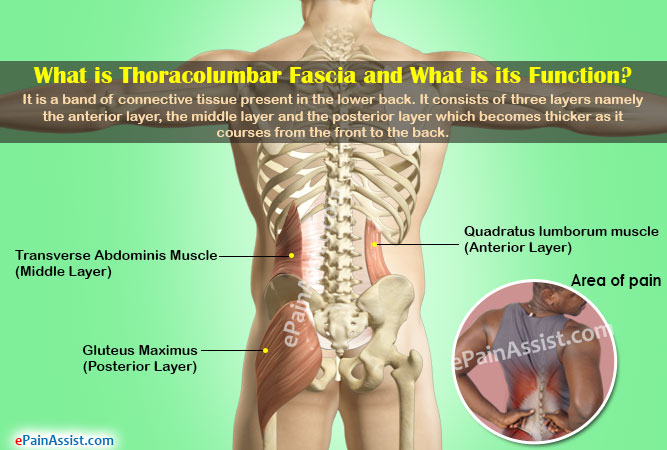What is Thoracolumbar Fascia and What is its Function?
The Thoracolumbar Fascia is a band of connective tissue present in the lower back.1 It consists of three layers namely the anterior layer, the middle layer and the posterior layer which becomes thicker as it courses from the front to the back. The Thoracolumbar Fascia has quite a few important muscles and tendon around it. The Quadratus Lumborum is present on the left of the Thoracolumbar Fascia. The Spinal Erectors are present on the right side of the Thoracolumbar Fascia.

Function of Thoracolumbar Fascia: The Thoracolumbar Fascia plays a key role in general locomotion of the body meaning that it facilitates stabilizing the body, generating and releasing the forces required by the body to move effectively such that an individual is able to ambulate normally without falling. Since Thoracolumbar Fascia is used frequently during an entire day hence it is prone to overuse and hence various injuries to it resulting in Thoracolumbar Fascia Pain.
Which Muscles are Associated with Thoracolumbar Fascia?
As stated above, the Thoracolumbar Fascia consists of three layer consists of three layers which are:
Anterior Layer: This layer attaches to the anterior aspect of the transverse processes of the lumbar spine and the anterior surface of the quadratus lumborum muscle.
Middle Layer: This layer attaches to the medial edge of the transverse processes resulting in formation of the Transverse Abdominis Muscle.
Posterior Layer: This layer covers all the muscles of the lumbosacral region through to the thoracic region. This layer attaches to both the erector spinae and gluteus maximus aponeurosis. This layer of the Thoracolumbar Fascia is the one which is actually responsible for a person being able to move and walk normally.
Signs of Thoracolumbar Fascia Injury Causing Thoracolumbar Fascia Pain
The signs and symptoms which may point to a thoracolumbar fascia injury resulting in thoracolumbar fascia pain are:
- Tightness of the lumbar spine and paraspinal region along with spasticity and increased tone
- Increased lumbar lordosis can cause thoracolumbar fascia pain.
- Persistent lumbar spine pain
- Locking of the sacroiliac joint
- Annoying shoulder and hip discomfort not improved with treatment
- Decrease in ability of the diaphragm to expand during breathing
- Decreased range of motion of the hip
- Difficulty walking
- Quadratus lumborum muscle weakness.
What is the Treatment for Thoracolumbar Fascia Pain?
The following are some of the treatment methods used for treating Thoracolumbar Fascia Pain:
Thoracolumbar Fascia Release: This can be done through manual therapy using soft tissue mobs. Some of the examples of this are active release, Rolfing, myofascial release and the like. Therapists also recommend laser therapy, ultrasound, and the like.
Brace: Wearing a back support brace can be helpful for people suffering from thoracolumbar fascia pain. Braces applies compression to the thoracolumbar spine.
Exercises for Thoracolumbar Fascia Pain
Apart from the conservative treatment for thoracolumbar fascia pain mentioned above, following exercises can also be helpful:
Bird Dog Exercise: To do this exercise, place the knees and hands flat on the floor. Place your hands at a shoulder-width distance with each other and your knees at hip-width distance. Keep the back flat and it should be parallel to the floor. Now, extend the right arm and simultaneously lift and extend the left leg off the ground such that both are parallel to the floor and in-line with the back. Maintain this position for about half a minute. The Thoracolumbar Fascia will have to support the position the raised arm and leg are in and maintain balance. Repeat the same thing with the other leg and arm and do it two to three times a day.
Plank Exercise for Thoracolumbar Fascia Pain: This exercise targets the thoracolumbar fascia and the transverse abdominis muscles, as these two muscles work in coordination to support the body while doing this exercise. To begin with, position your forearms on the ground and extend the legs such that the toes are on the ground but the heels are in the air. Maneuver your body such that you form a direct line from the legs to the upper back. This will cause the transverse abdominis and thoracolumbar muscles to contract and support the body. Maintain this position for about half a minute.
Flying Position Exercise for Thoracolumbar Fascia Pain: To do this exercise, you need to get into a prone position with the chest and stomach flat on the floor. The arms and legs should be on the floor and extended away from your body. Now lift the arms, chest and thighs off the floor of the as if you are flying like a superhero. Maintain this position for about 30 seconds.
Measures to Prevent Thoracolumbar Fascia Pain
Maintaining ideal body weight and maintaining proper posture can go a long way in preventing thoracolumbar fascia pain.
If your job involves a sedentary one, requiring you to sit for long hours, then it is important to take breaks on and off and stretch yourself a bit in order to prevent thoracolumbar fascia pain.
Also Read:
